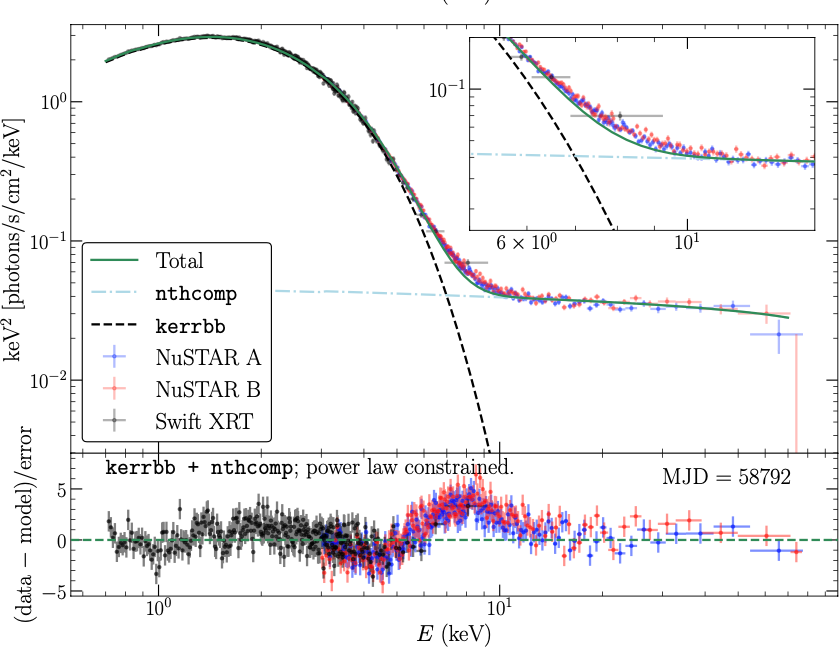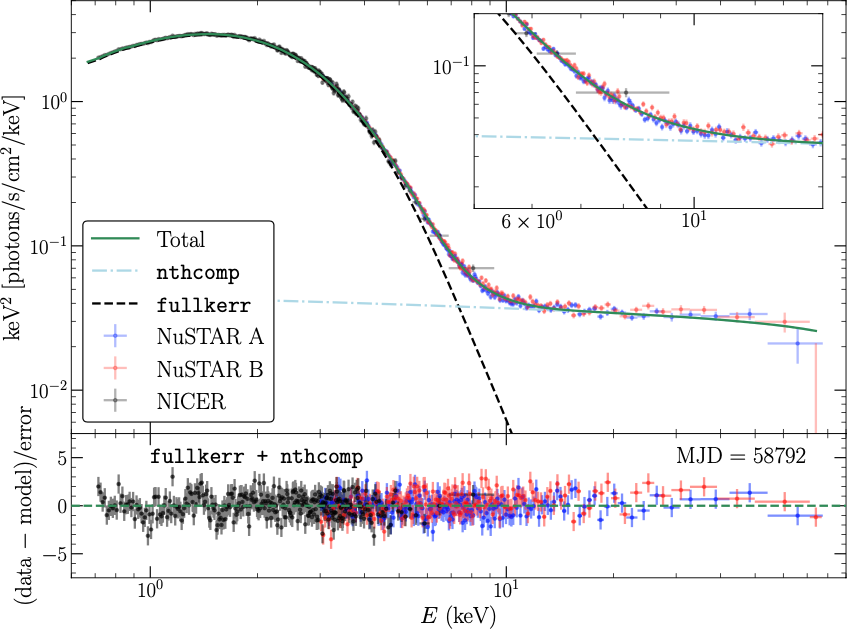NICER / ISS Science Nugget
for July 18, 2024
A second black-hole plunge
A recently developed theoretical model for the flow of matter just outside a black-hole's event horizon has gained additional support in a new peer-reviewed analysis published in the U.K. journal Monthly Notices of the Royal Astronomical Society.
A. Mummery (Oxford Univ.) and collaborators previously showed that data for the black-hole binary MAXI J1820+070 - collected by NICER and NASA's NuSTAR telescope, which complements NICER with sensitivity to higher-energy X-rays - are well described by their new model for superheated gas in the "plunging region." This region, which extends inward from the innermost stable circular orbit (ISCO) to the event horizon, was excluded from historical models of X-ray emission from an accretion disk, the flow that is established around a black hole when it draws matter from a companion star. In the high-quality datasets now available from NICER and NuSTAR, these older models appear to be inadequate, while the new model that includes the plunging region offers a clear improvement. Mummery et al. now show that the same is true for a second black-hole binary system, MAXI J0637-430, which was caught in outburst in November 2019. The plunging signature appears at X-ray energies that are accessible to both NICER and NuSTAR, and the combination of the two datasets is crucial: it pins down both the lowest-energy and highest-energy behaviors, accurately revealing the need for the new model's emission component from within the ISCO.
The ability to demonstrate the existence of emission from the plunging region is important because it directly probes the most extreme, strongest-gravity, conditions in the universe, and it reveals a key property of a black hole: its "spin." The angular momentum of a black hole is thought to grow as a result of accretion - both its duration and the quantity of matter accreted over time - so that a measurement of spin informs our understanding of the formation and evolution of the black hole. Einstein's theory of general relativity establishes a maximum spin for a given black-hole mass, and at this highest possible angular momentum, the ISCO and event-horizon coincide, so that the plunging region vanishes. As a result, the detection of a plunging region in X-ray spectra yields a robust upper limit to a black hole's spin rate. For MAXI J0637, Mummery et al. find the spin must be < 0.86, with 99.9% statistical confidence. Such measurements can be checked against results from the few other methods available for probing a black-hole's fundamental properties through X-ray spectroscopy and timing, serving to validate these approaches and our understanding of strong gravity.


Spectral fits to NICER and NuSTAR data of black-hole binary MAXI J0637-430 obtained quasi-simultaneously on 5 November, 2019. A traditional model for accretion-disk emission around a spinning black hole ("kerrbb") is applied in the left-hand figure; the inset and the residuals in the lower panel show a poor fit for photon energies between 6 and 10 keV, where NICER and NuSTAR coverage overlap. (Note that the legend of the left-hand figure mislabels the NICER data as having come from "Swift XRT".) In the right-hand plot, the new model that includes emission from the plunging region ("fullkerr") provides a much better fit to the same data. A separate model component in both fits, "nthcomp," accounts for emission from thermal disk photons that are boosted to higher energies by Compton scattering in a nearby hot plasma. (Credit: Mummery et al. 2024)
<< Previous
Main Index